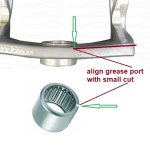sandkicker
Outstanding Contributor
Recommended grease for ujoints on a 280... other than the unobtainium "official" Volvo stuff.???
.... and how do you get grease into the "bearing" #32 on the Volvo Drive shop manual that holds the reverse latch mechanism ( curiously, this part is shown and referenced for the 290 drive and not the 280, so the #32 is the reference for a 290 drive)?
I lubed the fitting on the bottom of the yoke and the yoke moves freely with just minor finger tip pressure ( drive on a work stand), HOWEVER, the "bearing" that retains the reverse latch is quite stiff to move.
.... and how do you get grease into the "bearing" #32 on the Volvo Drive shop manual that holds the reverse latch mechanism ( curiously, this part is shown and referenced for the 290 drive and not the 280, so the #32 is the reference for a 290 drive)?
I lubed the fitting on the bottom of the yoke and the yoke moves freely with just minor finger tip pressure ( drive on a work stand), HOWEVER, the "bearing" that retains the reverse latch is quite stiff to move.
Last edited:




